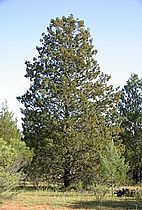Species
A selection of species that are commonly known as cypresses include the following (this is not a complete list; refer to the genus links for a fuller list for each genus):
- Cupressus :
- Cupressus atlantica (Moroccan cypress), Atlas Mountains in Morocco
- Cupressus austrotibetica (South Tibetan cypress), Parlung Tsangpo Gorges, southern Tibet
- Cupressus duclouxiana (Yunnan cypress), SW China
- Cupressus dupreziana (Saharan cypress), mountains of southern Algeria
- Cupressus funebris (Chinese weeping cypress), southern China
- Cupressus gigantea (Tibetan cypress), Tibet
- Cupressus sempervirens (Mediterranean cypress, also referred to as Italian cypress). [4] It is native to the eastern Mediterranean region to Iran.
- Cupressus torulosa (West Himalayan cypress), western Himalaya
- Callitropsis (often included in Cupressus):
- Callitropsis nootkatensis (Nootka cypress), western North America
- Hesperocyparis (often included in Cupressus):
- Hesperocyparis arizonica (Rough-barked Arizona cypress), Arizona, southwest New Mexico, northern Mexico
- Hesperocyparis bakeri (Modoc cypress), California, southwestern Oregon
- Hesperocyparis glabra (Smooth Arizona cypress), Arizona
- Hesperocyparis goveniana (Gowen's cypress), California
- Hesperocyparis lusitanica , (Mexican cypress), Mexico and Central America. [5]
- Hesperocyparis macnabiana (MacNab's cypress), California
- Hesperocyparis macrocarpa (Monterey cypress), California
- Hesperocyparis pygmaea (Mendocino cypress), California
- Hesperocyparis sargentii (Sargent's cypress), California
- Xanthocyparis (often included in Cupressus):
- Xanthocyparis vietnamensis (Vietnamese golden cypress), Vietnam, extreme southern China
- Chamaecyparis : eastern Asia and North America. [6]
- Chamaecyparis formosensis (Formosan cypress), Taiwan
- Chamaecyparis lawsoniana (Lawson's cypress). [7] This is a native species to Oregon and northwestern California. [7]
- Chamaecyparis obtusa (hinoki cypress), Japan, Taiwan
- Chamaecyparis pisifera (sawara cypress), Japan
- Chamaecyparis thyoides (white cypress), southeastern USA
- Fokienia (often included in Chamaecyparis):
- Fokienia hodginsii (Fujian cypress), southeastern China, eastern Indochina [8]
- Microbiota
- Microbiota decussata (Siberian cypress), Sikhote-alin, Russian far east
- Taxodium:
- Taxodium ascendens (pond cypress), southeastern United States. [9] and native to North America.
- Taxodium distichum (bald cypress), southeastern United States. [10]
- Taxodium mucronatum (Montezuma cypress or Montezuma bald cypress), Mexico, Guatemala, and southern-central United States. [11] [11]
- Glyptostrobus
- Chinese swamp cypress ( Glyptostrobus pensilis ), Vietnam, critically endangered [12]
- Austrocedrus
- Austrocedrus chilensis (Cordilleran cypress), native to Chile and Argentina [1]
- Fitzroya
- Fitzroya cupressoides (Patagonian cypress), southern Chile and Argentina
- Pilgerodendron
- Pilgerodendron uviferum (Guaitecas cypress), western Patagonia [13] and Tierra del Fuego [1]
- Widdringtonia (African cypresses), four species native to Southern Africa [14]
- Actinostrobus (often included in Callitris) – (cypress-pines), southwestern Australia [15]
- Callitris (cypress-pines), 16 species native to Australia and New Caledonia [16]
- Actinostrobus arenarius
- Austrocedrus chilensis
- Callitris preissii
- Cupressus macrocarpa, Monterey Peninsula, California
- Cupressus nootkatensis
- Fokienia hodginsii
- Fitzroya cupressoides
- Glyptostrobus pensilis foliage
- Taxodium ascendens, Okefenokee Swamp, Georgia (USA)










